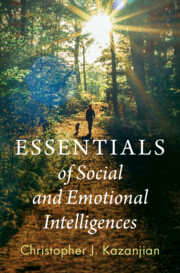235 results
The Role of Mindfulness in Reducing Depression During COVID-19 At-home Treatment
-
- Journal:
- Disaster Medicine and Public Health Preparedness / Volume 19 / 2025
- Published online by Cambridge University Press:
- 16 April 2025, e97
-
- Article
- Export citation
Chapter 5 - Mindful Self-Awareness
-
- Book:
- Essentials of Social and Emotional Intelligences
- Published online:
- 25 March 2025
- Print publication:
- 27 March 2025, pp 104-134
-
- Chapter
- Export citation

Essentials of Social and Emotional Intelligences
-
- Published online:
- 25 March 2025
- Print publication:
- 27 March 2025
Resilient living program for patients with advanced cancer and their caregivers
-
- Journal:
- Palliative & Supportive Care / Volume 23 / 2025
- Published online by Cambridge University Press:
- 14 March 2025, e75
-
- Article
-
- You have access
- Open access
- HTML
- Export citation
Mindfulness-based cognitive therapy for depression after traumatic brain injury: responders’ characteristics
-
- Journal:
- The Cognitive Behaviour Therapist / Volume 18 / 2025
- Published online by Cambridge University Press:
- 11 February 2025, e7
-
- Article
-
- You have access
- Open access
- HTML
- Export citation
6 - Mindfulness and Enjoying the Moment
-
- Book:
- Brain Boost
- Published online:
- 23 January 2025
- Print publication:
- 23 January 2025, pp 68-77
-
- Chapter
- Export citation
8 - Pain
-
-
- Book:
- Science-Based Therapy
- Published online:
- 10 January 2025
- Print publication:
- 16 January 2025, pp 122-138
-
- Chapter
- Export citation
18 - Attention-Deficit/Hyperactivity Disorder
-
-
- Book:
- Science-Based Therapy
- Published online:
- 10 January 2025
- Print publication:
- 16 January 2025, pp 329-343
-
- Chapter
- Export citation
1 - Global Leaders in the 21st Century
- from Part I - The New Global Context
-
- Book:
- International Management Behavior
- Published online:
- 15 March 2025
- Print publication:
- 16 January 2025, pp 7-31
-
- Chapter
- Export citation
Chapter 11 - How and When Should I Deliver Cognitive Therapeutics?
- from Section 4 - Treating Insomnia Using the CBTx Approach
-
- Book:
- The Clinician's Guide to Cognitive and Behavioural Therapeutics (CBTx) for Insomnia
- Published online:
- 20 December 2024
- Print publication:
- 09 January 2025, pp 230-272
-
- Chapter
- Export citation
Association between mindfulness and risk and time preferences
-
- Journal:
- Journal of the Economic Science Association / Volume 10 / Issue 2 / December 2024
- Published online by Cambridge University Press:
- 01 January 2025, pp. 199-212
-
- Article
- Export citation
Biomarkers of racism-based stress injury: A feasibility and correlation study
-
- Journal:
- Journal of Clinical and Translational Science / Volume 9 / Issue 1 / 2025
- Published online by Cambridge University Press:
- 27 December 2024, e23
-
- Article
-
- You have access
- Open access
- HTML
- Export citation
Mindfulness-based relapse prevention for drug addiction in Nepal: impact and implications of an initial 2-day training of trainers
-
- Journal:
- BJPsych International / Volume 22 / Issue 1 / February 2025
- Published online by Cambridge University Press:
- 11 December 2024, pp. 19-21
- Print publication:
- February 2025
-
- Article
-
- You have access
- Open access
- HTML
- Export citation
15 - Cognitive Modelling of Spiritual Practices
- from Part III - Religious Studies
-
-
- Book:
- The Cambridge Companion to Religion and Artificial Intelligence
- Published online:
- 20 November 2024
- Print publication:
- 21 November 2024, pp 257-274
-
- Chapter
- Export citation
4 - The Mirror of Nature
- from Part II - Soul
-
- Book:
- Plotinus on the Contemplation of the Intelligible World
- Published online:
- 03 September 2024
- Print publication:
- 21 November 2024, pp 142-184
-
- Chapter
- Export citation
Treatment as a moderator and executive function as a mediator of the effect of a mindfulness ecological momentary intervention for generalized anxiety disorder
-
- Journal:
- Psychological Medicine / Volume 54 / Issue 13 / October 2024
- Published online by Cambridge University Press:
- 15 October 2024, pp. 3715-3728
-
- Article
-
- You have access
- Open access
- HTML
- Export citation
The transformative journey of community health workers in implementing a lifestyle intervention in Brazil: A qualitative study
-
- Journal:
- Journal of Clinical and Translational Science / Volume 8 / Issue 1 / 2024
- Published online by Cambridge University Press:
- 10 October 2024, e158
-
- Article
-
- You have access
- Open access
- HTML
- Export citation
‘Living in the Present’ mindfulness for parents of children with skin conditions: a single group case series
-
- Journal:
- Behavioural and Cognitive Psychotherapy / Volume 52 / Issue 6 / November 2024
- Published online by Cambridge University Press:
- 30 September 2024, pp. 561-580
- Print publication:
- November 2024
-
- Article
-
- You have access
- Open access
- HTML
- Export citation
Chapter 13: - Self-Care
-
- Book:
- Adultish
- Published online:
- 10 October 2024
- Print publication:
- 01 August 2024, pp 237-254
-
- Chapter
- Export citation
Teaching Mindfulness in Class, Bringing Mindfulness to Life: A Tribute to Charity Scott’s Impact on Mental Health and Well-Being in Law School and Legal Practice
-
- Journal:
- Journal of Law, Medicine & Ethics / Volume 52 / Issue 2 / Summer 2024
- Published online by Cambridge University Press:
- 22 October 2024, pp. 391-395
- Print publication:
- Summer 2024
-
- Article
- Export citation


